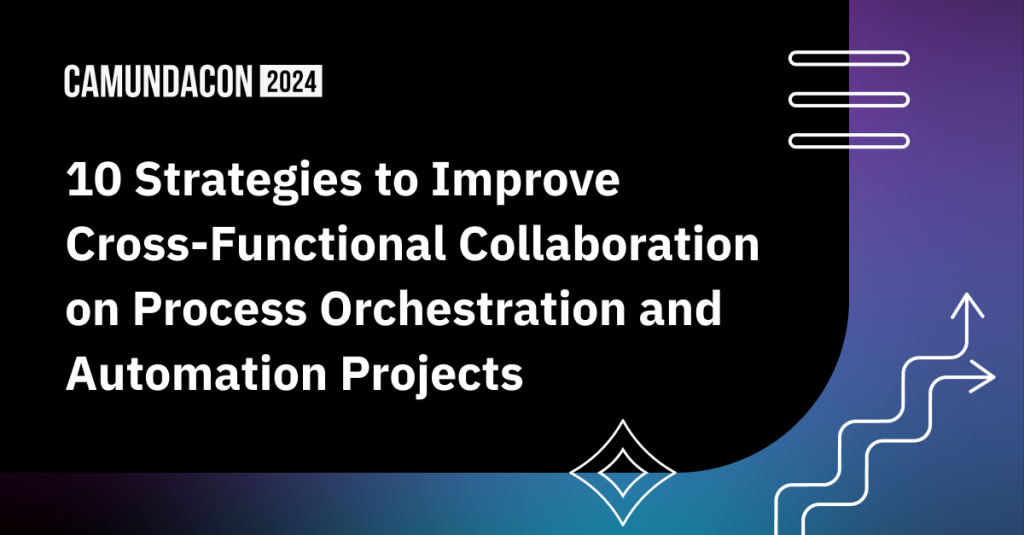Have you ever been part of a project where teams just couldn’t get on the same page? It’s a common struggle, especially for complex, cross-functional, transformational projects with multiple stakeholders. And the consequences can be costly.
For example, of the 800 senior IT decision-makers surveyed for our annual State of Process Orchestration & Automation report:
- 82% say miscommunication between teams leads to the wrong thing being built and/or rolled out to customers—up from 68% in 2024.
- 77% say the time it takes to design and agree upon process changes is a bottleneck at their organization—up from 73% in 2024.
- 62% say business users and IT cannot easily collaborate on individual processes and/or projects—up from 58% in 2024 who pointed to a disconnect between IT decision-makers and business leaders around their processes.
Poor cross-functional collaboration can threaten project success. It can also result in the wrong solutions being built, costly rework, and a frustrating experience for delivery teams and their customers.
What can leaders do to help disparate teams and stakeholders work more collaboratively and align more successfully on their process automation initiatives?
Camunda’s Helen Park, senior GSI partner director, posed that question to a panel of process automation and digital transformation experts at the 2024 CamundaCon in New York. Let’s go over their key takeaways.

Actionable advice for improving cross-functional collaboration
Set a collaborative tone right from the top.
1. Establish a shared vision and goals
Focus on the common goal, and ensure all stakeholders align on the same vision and outcomes. Clearly explain the purpose and goals of the project, how automation benefits the organization as a whole, and how those benefits tie back to the teams’ and organization’s charters.
“… human interactions, human communications, and planning for everybody to see the same vision and the goal to achieve the outcome—in most of these large process automation initiatives, that becomes the key success factor in terms of deciding the fate of the outcome.” –Prashant Gaonkar, V.P., Global Strategy and Planning, Enterprise Platforms, Cognizant
2. Foster vertical and horizontal alignment
Drive vertical alignment by clearly communicating the vision from the C-suite. Improve horizontal alignment and ensure collaboration across business, IT, and operational teams by selecting the right projects and technologies, communicating requirements for each team, and tracking and sharing the value delivered to project stakeholder teams.
“View alignment and collaboration across two axes. One is a vertical axis where you have to have a C-level vision that actually drives the effort and is clearly articulated and disseminated throughout the entire organization because otherwise, you will not drive alignment down to the user level… The second axis we see is horizontal alignment across business, which drives how you select projects for automation in the first place, how you select technology, communicate requirements between business and IT, and ultimately how you communicate or track the value delivered by these initiatives back to the business.” –Frederic Meier, S.V.P., Sales, Camunda
3. Promote transparency and trust
Be open about automation goals, potential impacts, outcomes, and business value. Address potential concerns, such as planned job displacements, reorganizations, or new operational processes with clear messaging on the organizational benefits.
“You’ve got to offer up trust before anybody offers it back to you.” -Mike Hastie, Major Healthcare Insurer
4. Break down silos with a “win together” mindset
Encourage a culture where all teams work toward collective success, ensuring that departmental priorities do not hinder collaboration.
“Silos are there when there’s a fear of missing out, a fear of losing power or control or the organizational design in terms of boundaries and barriers. That’s when you create silos. But if you align everybody with a single goal/outcome—‘everybody wins or nobody wins’—the message becomes very easy. The silos break down, then they work together.” –Prashant Gaonkar
“You need a product that allows you to create alignment between business and IT. Our approach to process orchestration and automation is, of course, one where it’s the literal representation of what business wants when you talk about the BPMN process. It is also a visualization of what is actually being automated, and that allows you to give the business visibility back into an automated project. Now you can track results, you can visualize results, and you can speak the language of the business better.” –Frederic Meier
Manage proactively and inclusively
5. Take a “four-legged-table” approach
Think of product, tech, design, and business partners as four legs of a table. All four need to be even for the table to be functional.
“If you have one leg or a couple legs that are not in sync, then you’re not going to have a successful product development. So I think leadership setting the right tone, right culture from the top is key.” –Bhargav Trivedi, Senior Director of Software Engineering, Capital One
6. Cultivate “extreme ownership”
Encourage leaders and team members to take full responsibility for project success by proactively taking any steps necessary to make sure the project is done correctly.
“We all need to demonstrate that for a successful implementation… to say ‘I own this. I need to make this successful.’” –Bhargav Trivedi
7. Engage with empathy
Understand that the teams and stakeholders on your project have other priorities as well. Taking time to acknowledge their concerns and their perspective helps drive buy-in and reduce resistance.
“Different groups all have other priorities. You have to have empathy towards their priorities. You have to understand them.” –Prashant Gaonkar
“Put yourself in the shoes of your customer or your stakeholders who are going to be impacted by the project. Make sure that you think from their perspective… Make them feel that they are included in the process.” –Bhargav Trivedi
Structure your communications
8. Construct a collaboration framework
Define clear communication structures, decision-making roles, and engagement forums to keep teams aligned; for example, daily scrums, status reports, value-tracking meetings.
“When you start a big project where multiple stakeholders are involved, you have to set up a structure of how you’re going to communicate; the forums that you want to bring in; who is the decision maker for each of those forums; who is responsible; what kind of content are you going to talk about in each forum; and maximize efficiency across the board… What’s necessary for you will be determined by the nature of the work you are doing, the state of the product development you are in, then go from there. Having more forums in the beginning would not hurt, and you can pare it back once you have established trust and norms across the whole program and stakeholders.” –Bhargav Trivedi
9. Leverage metrics for fact-based discussions
Use KPIs and value-tracking frameworks to communicate impact, measure success, and create alignment around data-driven outcomes. Articulate the business value and impact on business teams with KPIs.
“If you’ve got metrics, you can start making the conversation fact-based. That always helps drive out a better conversation. When it’s very clear what you need to fix, that makes it easier for people to establish a goal and drive towards an outcome.” -Mike Hastie
“Focus on the business value and the KPIs you have been able to achieve. Articulate the actual impact to business teams and their KPIs by doing a value workshop and working with partners to articulate that. Once you do that, the business is going to understand the real impact the solution will have.” –Frederic Meir
Take advantage of new, AI-based tools
10. Adopt future-proof mindsets and technologies
Embrace AI, real-time intelligence, and process orchestration tools to enhance collaboration and efficiency while staying ahead of emerging tech trends.
“Everything is going to end up with AI in it. Let me give you a heads-up: If we don’t give our customer what they want, if we don’t deliver the value they want, if we don’t get the value they want, they will find their own technology to deliver it for them. We need to embrace new technologies, find the potential in them, leverage the potential, and not fall into the hype cycle. There is a huge opportunity for us to use tech to be the best versions of ourselves.” –Mike Hastie
Learn how Camunda helps business and IT teams collaborate better
Camunda is designed to help organizations collaboratively build better, more efficient automations and get to market faster. The platform uses open standards like business process model and notation (BPMN) and decision model and notation (DMN) to align teams with a common model and language. It also gets low-code and pro-code teams to unite on a clear, shared vision and outcome.
See how Camunda’s platform can help you accelerate transformation, and join us at the next CamundaCon to meet and learn from leading organizations that are achieving amazing transformations with process orchestration.



Start the discussion at forum.camunda.io